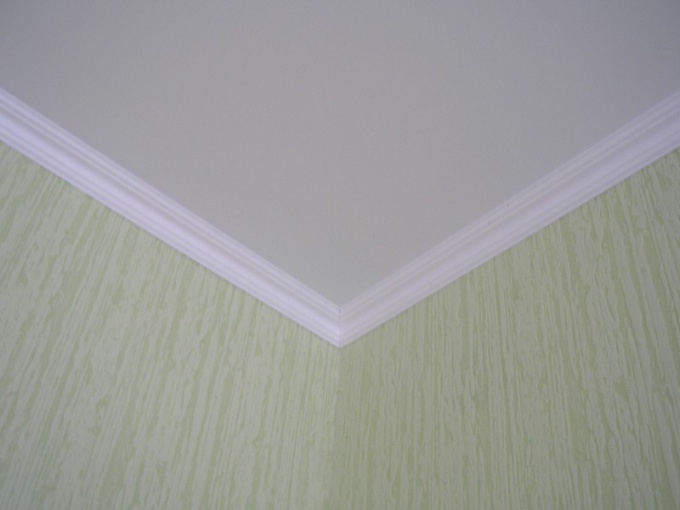Ceiling moldings can be, for example, moldings, molding or frieze. It is a decorative element that helps give the interior decoration of perfection, aesthetic appearance. It can be used to hide imperfections, small blemishes at the junction of wall and ceiling.
For the manufacture can be made of different materials - the plinth may be a plastic foam, wood, plaster, polyurethane, etc.
Most baseboards are used such funds.
Adhesives polymer based. Of these, the most common "Point" and "Titan". Not only do they have a good knitting Foundation, but they are grabbed pretty quickly, and items glued with their help, will be kept securely. There are other similar adhesive solution on the basis of polymers, but their adhesive properties are somewhat worse.
Liquid nails. Safe for almost all materials can perfectly hold the baseboard in the long term. Such compositions are neopredelennoe – they have a pungent smell and rough handling prior to drying, can cause harm, and acrylic – safer, but less effective.
Putty based on acrylic. Facing workers, many professionals choose it because of the putty to stick skirting is very convenient:
- won't need long to press to the surface of the baseboard and wait until it solidifies;
- the same structure, you can immediately cover the gap between the wall and the baseboard, in the presence of the bumps to flatten them out.
The putty will securely hold material to use in enclosed areas without fear for their health.
To finish ceilings of domestic premises often choose a plinth made of polystyrene foam. The materials and practical, and inexpensive, and does not look worse than plaster or wood. You can simulate the hall of columns, and it happens not so expensive. Most effective and safer to stick moldings foam with acrylic putty.
Liquid nails and other adhesives also can be used, but only if the composition allows it. On the packaging must be indicated indications for use.
Adhesive for ceiling moldings can be made independently. Need not so many components: the finishing plaster, PVA glue, water. In a container with sufficient filled filler, it is added to PVA in a ratio of 4:1. Water is added, the solution is mixed to a creamy consistency. After this you should give it to stand for about 10 minutes and stir again. To use the thus prepared solution can be within a half to two hours.
For the manufacture can be made of different materials - the plinth may be a plastic foam, wood, plaster, polyurethane, etc.
To choose what it is possible to glue ceiling moldings, it is necessary depending on its material.
Means for gluing skirting boards
Most baseboards are used such funds.
Adhesives polymer based. Of these, the most common "Point" and "Titan". Not only do they have a good knitting Foundation, but they are grabbed pretty quickly, and items glued with their help, will be kept securely. There are other similar adhesive solution on the basis of polymers, but their adhesive properties are somewhat worse.
Liquid nails. Safe for almost all materials can perfectly hold the baseboard in the long term. Such compositions are neopredelennoe – they have a pungent smell and rough handling prior to drying, can cause harm, and acrylic – safer, but less effective.
Putty based on acrylic. Facing workers, many professionals choose it because of the putty to stick skirting is very convenient:
- won't need long to press to the surface of the baseboard and wait until it solidifies;
- the same structure, you can immediately cover the gap between the wall and the baseboard, in the presence of the bumps to flatten them out.
The putty will securely hold material to use in enclosed areas without fear for their health.
What glue skirting foam
To finish ceilings of domestic premises often choose a plinth made of polystyrene foam. The materials and practical, and inexpensive, and does not look worse than plaster or wood. You can simulate the hall of columns, and it happens not so expensive. Most effective and safer to stick moldings foam with acrylic putty.
Liquid nails and other adhesives also can be used, but only if the composition allows it. On the packaging must be indicated indications for use.
The use of adhesives containing aggressive substances may end because the baseboard will melt and spoil.
Adhesive for ceiling moldings can be made independently. Need not so many components: the finishing plaster, PVA glue, water. In a container with sufficient filled filler, it is added to PVA in a ratio of 4:1. Water is added, the solution is mixed to a creamy consistency. After this you should give it to stand for about 10 minutes and stir again. To use the thus prepared solution can be within a half to two hours.
